NCERT Solutions for Class 11 Maths Chapter 1 Sets
In NCERT Solutions for class 11 Maths Chapter 1 Sets, you will learn about the description of a Set, types of sets, subsets, concepts of subsets, Venn Diagrams, Operations on Sets using Venn Diagrams, Laws of Algebra of sets, some important results on number of elements in sets.
Free download NCERT Solutions for Class 11 Maths Chapter 1 Sets Ex 1.1, Ex 1.2, Ex 1.3, Ex 1.4, Ex 1.5, Ex 1.6 and Miscellaneous Exercise PDF in Hindi Medium as well as in English Medium for CBSE, Uttarakhand, Bihar, MP Board, Gujarat Board, BIE, Intermediate and UP Board students, who are using NCERT Books based on updated CBSE Syllabus for the session 2019-20.
Topics and Subtopics in Class 11 Maths NCERT Solutions Chapter 1 Sets
| Section Name | Topic Name |
| 1 | Sets |
| 1.1 | Introduction |
| 1.2 | Sets and their Representations |
| 1.3 | The Empty Set |
| 1.4 | Finite and Infinite Sets |
| 1.5 | Subsets |
| 1.6 | Power Set |
| 1.7 | Universal Set |
| 1.8 | Venn Diagrams |
| 1.9 | Operations on Sets |
| 1.10 | Complement of a Set |
| 1.11 | Practical Problems on Union and Intersection of Two Sets |
| 1.12 | Summary |
Class 11 Maths NCERT Solutions Chapter 1 Sets Ex 1.2
Q.1: Which of the following given below is null set?
(i). Set of odd natural numbers which is divisible by 2.
(ii). Set of even numbers which are prime
(iii). {x: x is a natural number, x<5 and x>7}
(iv). {y: y is a point common to any two parallel lines}
Solution: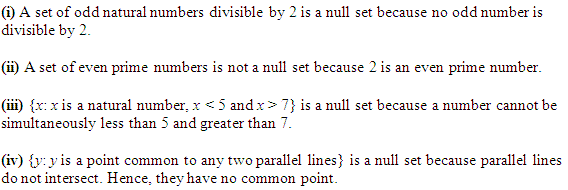
Q.2: State whether the following sets are infinite or finite:
(i). A set of months of a year.
(ii). {1, 2, 3 ….}
(iii). {1, 2, 3…99, 100}
(iv). The set of positive integers which are greater than 100.
(v). The set of prime numbers which are less than 99
Solution: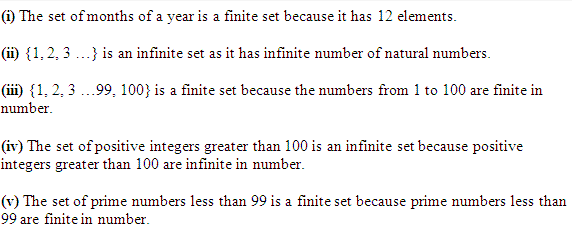
Q.3: State whether the following sets are infinite or finite:
(i). The set of lines parallel to the x – axis.
(ii). The set of letters in the vowels.
(iii). The set of numbers multiple of 10.
(iv). The set of humans living on Earth.
(v). The set of circles passing through the origin (0, 0).
Solution: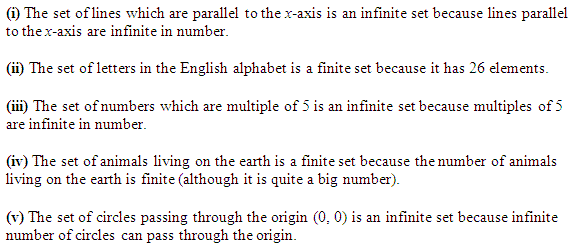
Q.4: In the following set given below, state whether A = B or not:
(i). A = {w, x, y, z}
B = {z, y, x, w}
(ii). A = {5, 9, 13, 17}
B = {9, 5, 17, 19}
(iii). A = {4, 2, 6, 10, 8}
B = {x: x is positive even integer and x≤10 }
(iv). A = {x: x is a multiple of 10}
B = {10, 15, 20, 25, 30 …}
Solution: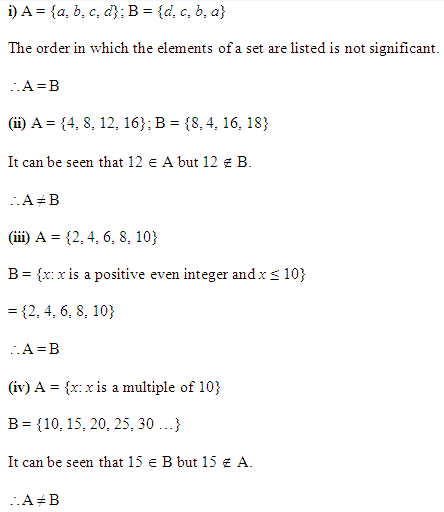
Q.5 In the following set given below, is the pair of sets equal?
(i). A = {3, 4}
B = {y: y is solution of y²+5y+6=0}
(ii). A = {a: a is a letter in the word FOLLOW}
B = {b: b is a letter in the word WOLF}
Solution: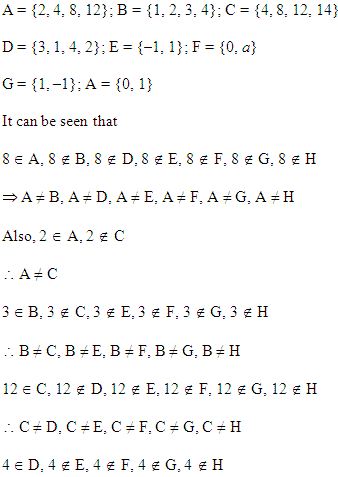
Q.6: From the following sets, select equal sets:
A = {2, 4, 8, 12}
B = {1, 2, 3, 4}
C = {4, 8, 12, 14}
D = {3, 1, 4, 2}
E = {–1, 1}
F = {0, a}
G = {1, –1}
H = {0, 1}
Solution: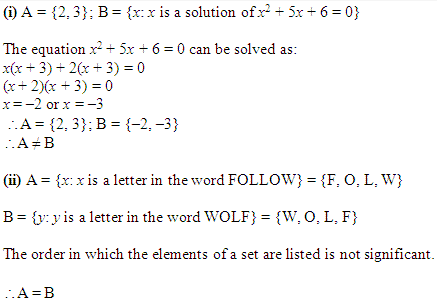
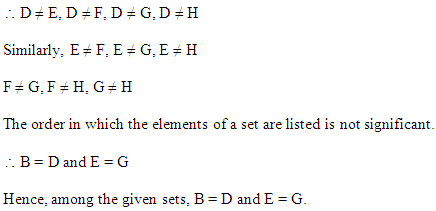
Class 11 Maths NCERT Solutions Chapter 1 Sets Ex 1.2
Q.1: Which of the following given below is null set?
(i). Set of odd natural numbers which is divisible by 2.
(ii). Set of even numbers which are prime
(iii). {x: x is a natural number, x<5 and x>7}
(iv). {y: y is a point common to any two parallel lines}
Solution:
Q.2: State whether the following sets are infinite or finite:
(i). A set of months of a year.
(ii). {1, 2, 3 ….}
(iii). {1, 2, 3…99, 100}
(iv). The set of positive integers which are greater than 100.
(v). The set of prime numbers which are less than 99
Solution:
Q.3: State whether the following sets are infinite or finite:
(i). The set of lines parallel to the x – axis.
(ii). The set of letters in the vowels.
(iii). The set of numbers multiple of 10.
(iv). The set of humans living on Earth.
(v). The set of circles passing through the origin (0, 0).
Solution:
Q.4: In the following set given below, state whether A = B or not:
(i). A = {w, x, y, z}
B = {z, y, x, w}
(ii). A = {5, 9, 13, 17}
B = {9, 5, 17, 19}
(iii). A = {4, 2, 6, 10, 8}
B = {x: x is positive even integer and x≤10 }
(iv). A = {x: x is a multiple of 10}
B = {10, 15, 20, 25, 30 …}
Solution:
Q.5 In the following set given below, is the pair of sets equal?
(i). A = {3, 4}
B = {y: y is solution of y²+5y+6=0}
(ii). A = {a: a is a letter in the word FOLLOW}
B = {b: b is a letter in the word WOLF}
Solution:
Q.6: From the following sets, select equal sets:
A = {2, 4, 8, 12}
B = {1, 2, 3, 4}
C = {4, 8, 12, 14}
D = {3, 1, 4, 2}
E = {–1, 1}
F = {0, a}
G = {1, –1}
H = {0, 1}
Solution:

Class 11 Maths NCERT Solutions Chapter 1 Sets Ex 1.3
Q.1: Fill in the blanks properly using ⊂ and ⊄.
(i). {3, 4, 5} ____ {2, 3, 4, 5, 6}
(ii). {a, b, c} ____ {d, c, d}
(iii). {y: y is a pupil of Class 11 of the school} ____ {y: y is students of the school}
(iv). {y: y is a circle in the plane} ____ {y: y is a circle in the same plane with radius 2 unit}
(v). {y: y is an equilateral triangle in a plane} ____ {y: y is a rectangle in the same plane}
(vi). {y: y is an equilateral triangle in a plane} ____ {y: y is a triangle in the plane}
(vii). {y: y is an odd natural number} ____ {x: x is an integers}
Solution: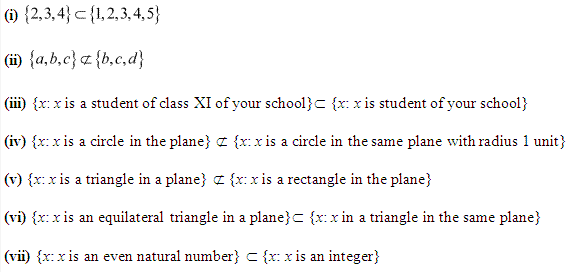
Q.2: State whether the given statements are true or false:
(i). {b, c} ⊄ {c, d, e}
(ii). {a, e, i} ⊂ {x: x is a vowel in the English alphabets}
(iii). {1, 2, 3} ⊂{1, 2, 4, 5}
(iv). {c} ⊂ {b, c, d}
(v). {b} ∈ {a, b, c, d}
(vi). {y: y is an even natural no. less than 6} ⊂ {y: y is a natural no. which can divide 36}
Solution: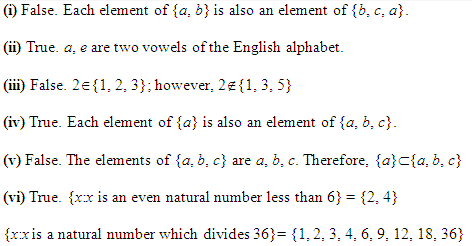
Q.3: Let X = {11, 12, {13, 14}, 15}. According to the given set which of the given statements are false? Explain why.
(i). {13, 14} ⊂ X
(ii). {13, 14} ∈ X
(iii). {{13, 14}} ⊂ X
(iv). 11 ∈ X
(v). 11 ⊂ X
(vi). {11, 12, 15} ⊂ X
(vii). {11, 12, 15} ∈ X
(viii). {11, 12, 13} ⊂ X
(ix). Ø ∈ X
(x). Ø ⊂ X
(xi). {Ø} ⊂ X
S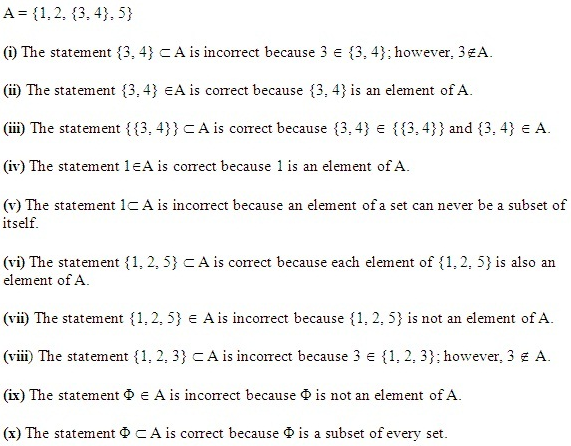

Q.4: Write all the subsets of the given sets:
(i). {b}
(ii). {b, c}
(iii). {2, 3, 4}
(iv). Ø
Solution: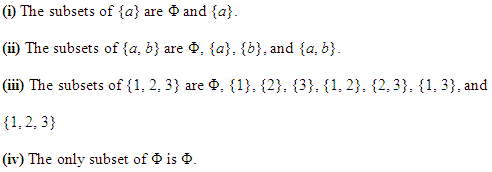
Q.5: How many elements has P(X), if X = Ø ?
Solution:
Q.6: Write the given in the form of intervals:
(i). {y: y ∈ R, –5 < y ≤ 7}
(ii). {y: y ∈ R, –13 < y < –11}
(iii). {y: y ∈ R, 1 ≤ y < 8}
(iv). {y: y ∈ R, 4 ≤ y ≤ 5}
Solution: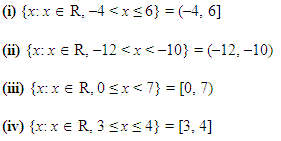
Q.7: Write the given intervals in the form of set – builder:
(i). (–4, 1)
(ii). [7, 13]
(iii). (7, 13]
(iv). [–24, 6)
Solution: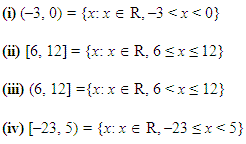
Q.8: What universal set/ sets would you propose for the given sets?
(i). The set of right triangles
(ii). The set of isosceles triangles
Solution:
Q.9: X = {1, 3, 5}, Y = {2, 4, 6} and Z = {0, 2, 4, 6, 8}
Which of the given sets can be considered as the universal set for the given sets X, Y and Z?
(i). {0, 1, 2, 3, 4, 5, 6}
(ii). Ø
(iii). {0, 1, 2, 3, 4, 5, 6, 7, 8, 9, 10}
(iv). {1, 2, 3, 4, 5, 6, 7, 8}
Solution: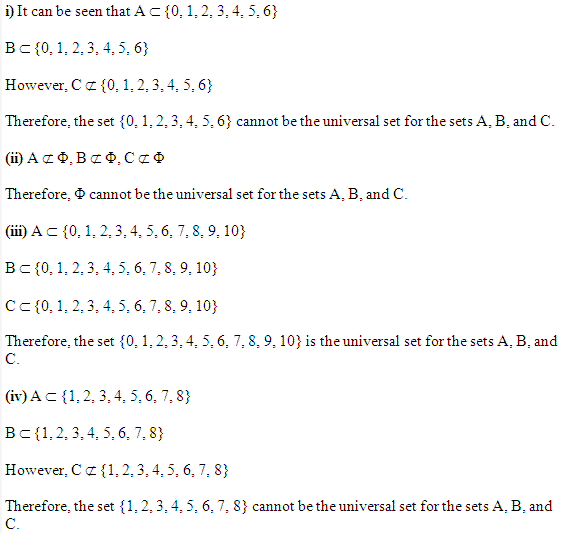
Class 11 Maths NCERT Solutions Chapter 1 Sets Ex 1.4
Q.1: Find the union of each of the following pairs of sets:
(i). P = {1, 4, 6} and Q = {1, 3, 4}
(ii). X = {a, e, i, o, u} and Y = {x, y, z}
(iii). X = {x: x is a natural number and multiple of 3} and Y = {x: x is a natural number less than 6}
(iv). X = {x: x is a natural number and 1 < x ≤ 5} and Y = {x: x is a natural number and 5 < x < 10}
(v). X = {4, 5, 6} and Y = Φ
Solution: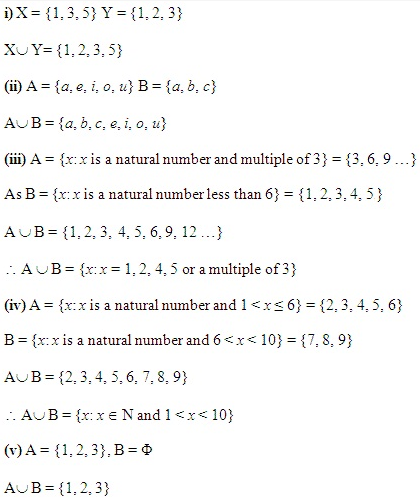
Q.2: Let A = {x, y} and B = {x, y, z}
Is A ⊂ B? What is A ∪ B?
Solution:
Q.3: If X and Y are two sets such that X ⊂ Y, then what is X ∪ Y?
Solution:![]()
Q.4: If P = {1, 2, 3, 4}, Q = {3, 4, 5, 6}, R = {5, 6, 7, 8} and S = {7, 8, 9, 10}
Find the following:
(i). P ∪ Q
(ii). P ∪ R
(iii). Q ∪ R
(iv). Q ∪ S
(v). P ∪ Q ∪ R
(vi). P ∪ Q ∪ S
(vii). Q ∪ R ∪ S
Solution: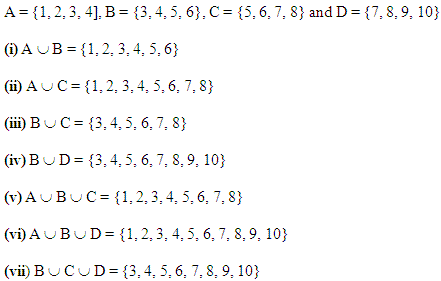
Q.5: Find the intersection of each of the following pairs of sets:
(i). P = {1, 4, 6} and Q = {1, 3, 4}
(ii). X = {a, e, i, o, u} and Y = {x, y, z}
(iii). X = {x: x is a natural number and multiple of 3} and Y = {x: x is a natural number less than 6}
(iv). X = {x: x is a natural number and 1 < x ≤ 5} and Y = {x: x is a natural number and 5 < x < 10}
(v). X = {4, 5, 6} and Y = Φ
Solution 5: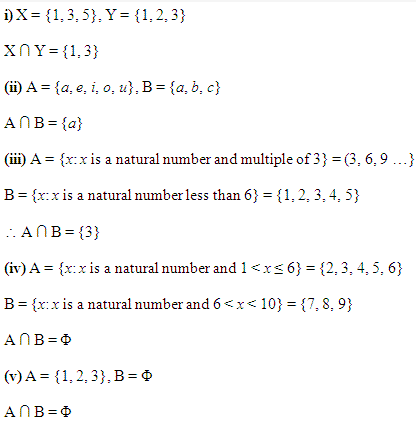
Q.6: If A = {3, 5, 7, 9, 11}, B = {7, 9, 11, 13}, C = {11, 13, 15} and D = {15, 17}
Find the following:
(i). A ∩ B
(ii). B ∩ C
(iii). A ∩ C ∩ D
(iv). A ∩ C
(v). B ∩ D
(vi). A ∩ (B ∪ C)
(vii). A ∩ D
(viii). A ∩ (B ∪ D)
(ix). (A ∩ B) ∩ (B ∪ C)
(x). (A∪ D) ∩ (B ∪ C)
Solution: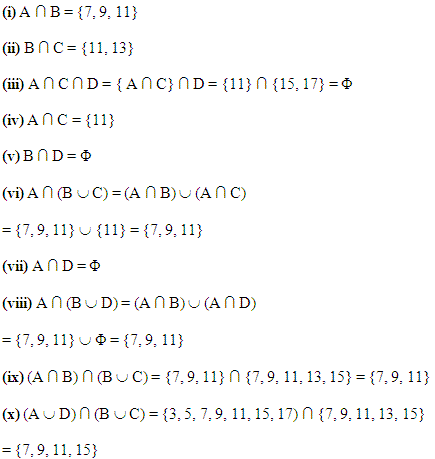
Q.7: If A = {y: y is a natural number}, B ={y: y is an even natural number}, C = {y: y is an odd natural number} and D = {y: y is a prime number}
Find the following:
(i). A ∩ B
(ii). A ∩ C
(iii). A ∩ D
(iv). B ∩ C
(v). B ∩ D
(vi). C ∩ D
Solution 7: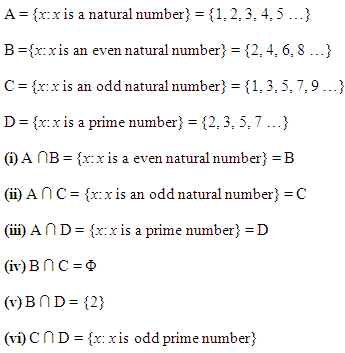
Q.8: Which of the given pairs of sets are disjoint?
(i). A = {1, 2, 3, 4} and B = {x: x is a natural number and 4 ≤ x ≤ 6}
(ii). A = {a, e, i, o, u} and B = {c, d, e, f}
(iii). A = {x: x is an even integer} and B = {x: x is an odd integer}
Solution: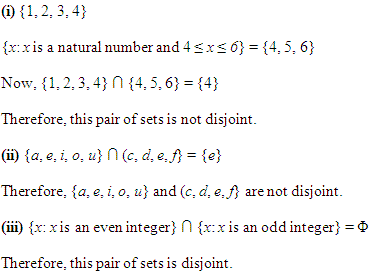
Q.9: If A = {3, 6, 9, 12, 15, 18, 21}, B = {4, 8, 12, 16, 20}, C = {2, 4, 6, 8, 10, 12, 14, 16} and D = {5, 10, 15, 20}
Find the following:
(i). A – B
(ii). A – C
(iii). A – D
(iv). B – A
(v). C – A
(vi). D – A
(vii). B – C
(viii). B – D
(ix). C – B
(x). D – B
(xi). C – D
(xii). D – C
Solution 9: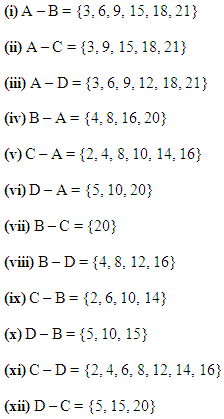
Q.10: If X = {a, b, c, d} and Y = {f, b, d, g}
Find the following:
(i). X – Y
(ii). Y – X
(iii). X ∩ Y
Solution: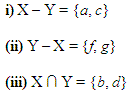
Q.11: What is R – Q, if R is the set of real numbers and Q is the set of rational?
Solution:
Q.12: State whether the following statements are true or false. Give reason.
(i). A = {2, 3, 4, 5} and B = {3, 6} are disjoint sets.
(ii). A = {a, e, i, o, u } and B = {a, b, c, d} are disjoint sets.
(iii). A = {2, 6, 10, 14} and B = {3, 7, 11, 15} are disjoint sets.
(iv). A = {2, 6, 10} and B = {3, 7, 11} are disjoint sets.
Solution: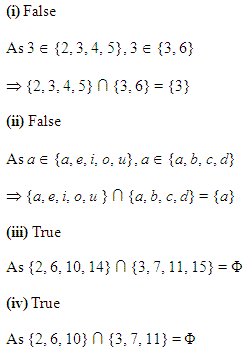
Class 11 Maths NCERT Solutions Chapter 1 Sets Ex 1.5
Q.1: Let U = {1, 2, 3, 4, 5, 6, 7, 8, 9}
X = {1, 2, 3, 4, 5}
Y = {2, 4, 6} and
Z = {2, 4, 5, 6}.
Find the following sets:
(i). X’
(ii). Y’
(iii). (X∪Y)′
(iv). (X∪Z)′
(v). (X′)‘
(vi). (Y–Z)′
Solution: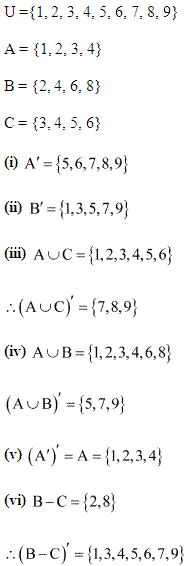
Q.2: If U = {a, b, c, d, e, f, g, h}, find the complements of the given sets:
(i). W = {a, b, c}
(ii). X = {d, e, f, g}
(iii). Y = {a, c, e, g}
(iv). Z = {f, g, h, a}
Solution: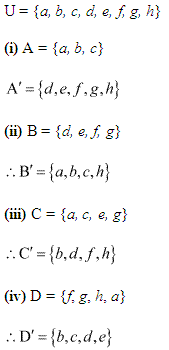
Q.3: Take natural numbers as the universal set. Write the complements of the given sets:
(i). A = {y: y is an even natural number}
(ii). B = {y: y is an odd natural number}
(iii). C = {y: y is a positive multiple of 3}
(iv). D = {y: y is a prime number}
(v). E = {y: y is a natural number divisible by 3 and 5}
(vi). F = {y: y is a perfect square}
(vii). G = {y: y is perfect cube}
(viii). H = {y: y + 5 = 8}
(ix). I = {y: 2y + 5 = 9}
(x). J = {y: y ≥ 7}
(xi). K = {y: y ∈ N and 2y + 1 > 10}
Solution: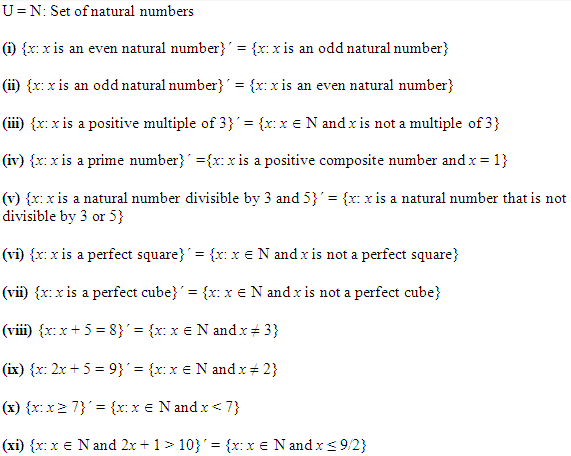
Q.4: If U = {1, 2, 3, 4, 5,6,7,8, 9}
A = {2, 4, 6, 8} and, B = {2, 3, 5, 7}.
Verify that:
(i). (A∪B)′ = A′∩B′
(ii). (A∩B)′ = A′∪B′
Solution: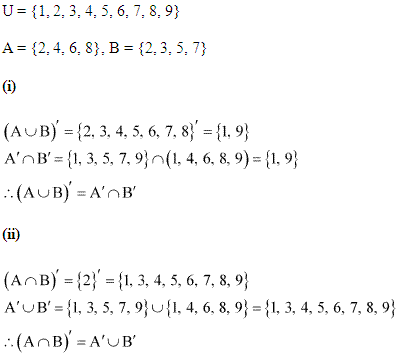
Q.5: Draw the Venn diagrams for the following:
(i). (A∪B)′
(ii). A′∩B′
(iii). (A∩B)′
(iv). A′∪B′
Solution:
Q.6: Let U be the universal set that is the set of all triangles in a plane. If X is the set of all triangles with at least one angle different from 60∘, what is X’ ?
Solution:![]()
Q.7: Complete the given statements using proper symbols:
(i). A∪A′
(ii). Ø ∩A
(iii). A∩A′
(iv). U′∩A
Solution: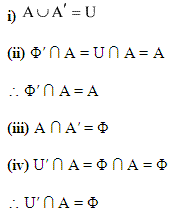
Class 11 Maths NCERT Solutions Chapter 1 Sets Ex 1.6
Q.1: If A and B are two sets such that n(A) = 16, n(B) = 24 and n(A∪B) = 39. Find n(A∩B).
Solution: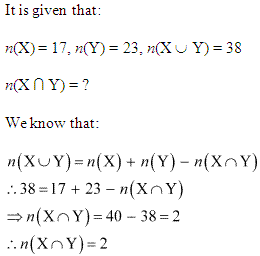
Q.2: If A and B are two sets such that A∪B has 17 elements, A has 9 elements and B has 14 elements. How many elements does A∩B have?
Solution: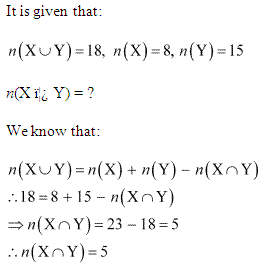
Q.3: In a group there are 450 people, 200 speaks Hindi and 270 can speak English. How many people can speak both English and Hindi?
Solution: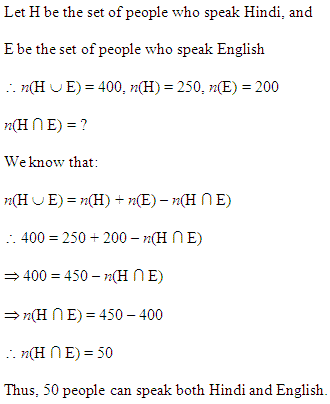
Q.4: If X and Y are two sets such that X has 22 elements, Y has 34 elements, and n(X∩Y) has 10 elements, how many elements does n(X∪Y) have?
Solution: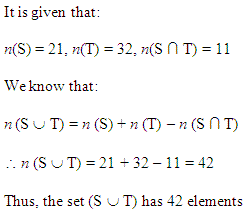
Q.5: If A and B are two sets such that A has 45 elements, n (A ∩ B) has 15 elements and n (A ∪ B) has 70 elements, how many elements does B have?
Solution: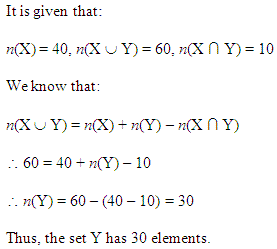
Q.6:There are 70 people, out of which 35 like tea, 55 like coffee, and each person likes at least one of the two beverages. How many people like both tea and coffee?
Solution: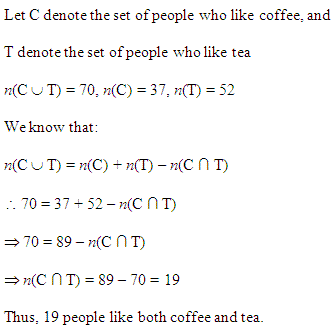
Q.7: There are 70 students in a group, 35 like cricket, 15 like both tennis and cricket. How many like tennis only and not cricket? How many like tennis?
Solution: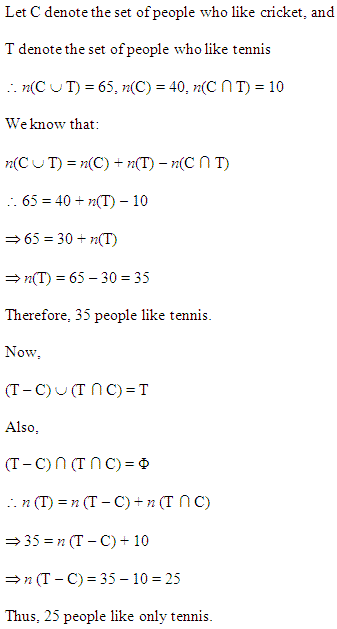
Q.8: In a committee, 60 people speak French, 30 speak Spanish and 20 speak both Spanish and French. How many speak at least one of these two languages?
Solution: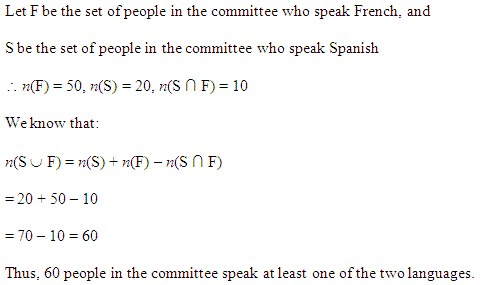
Post a Comment